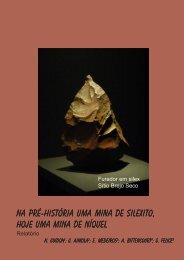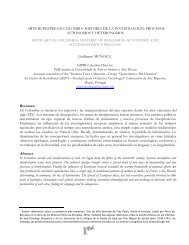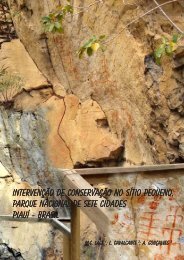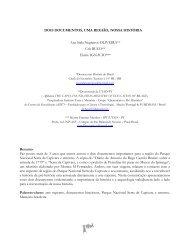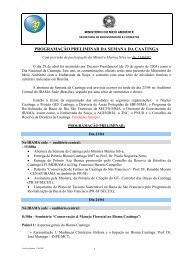Untitled - Fundação Museu do Homem Americano
Untitled - Fundação Museu do Homem Americano
Untitled - Fundação Museu do Homem Americano
You also want an ePaper? Increase the reach of your titles
YUMPU automatically turns print PDFs into web optimized ePapers that Google loves.
Enfoque Neurobiológico para el estudio de las representaciones rupestres<br />
Mónica Nélida Montal & M. Cecilia Panizza, Argentina<br />
Un tema subyacente en la investigación de la ejecución de las pinturas rupestres por los grupos humanos<br />
y escasamente estudia<strong>do</strong> hasta el momento, es la base neurológica que guía dichas acciones, es decir,<br />
qué sucede en el cerebro de los individuos que plasman las distintas representaciones sobre el substrato<br />
rocoso. Para tal fin nuestros argumentos son sosteni<strong>do</strong>s por distintas evidencias aportadas desde la<br />
Antropología y la Neurología. Se enfatiza el rol de la deformación craneana dentro de un contexto de<br />
adquisición de nuevos conocimientos o habilidades que posteriormente serían comunica<strong>do</strong>s por medio<br />
de las representaciones rupestres.<br />
Understanding the creation of cupules in Daraki-Chattan, Índia<br />
Giriraj Kumar, Índia<br />
34<br />
Recently cupules have been found in the excavations from Lower Palaeolithic deposits at Bhimbetka<br />
in Vindhyas and Daraki-Chattan in the Chambal basin. Daraki-Chattan yielded 28 cupules and some<br />
hammerstones in the excavations. It is one of the richest Palaeolithic cupule site in the world. To understand<br />
the technique of cupule production and link it with the recovered hammerstones it is essential to conduct<br />
replicative experiments. This will also help in correlating the hammerstones with the creation of specifi c<br />
types of cupules in Daraki-Chattan cave, and in understanding the intellectual and cognitive development<br />
of their producers in the Lower Palaeolithic period. With these objectives in mind, the senior author<br />
conducted experiments of replication of cupules in 2002 and 2004. In 2004 and 2008, the second author<br />
participated in the continuation of these. The authors were able to produce specific types of cupules,<br />
recording all details of production. The present paper presents new observations and lessons learned.<br />
It also gives an idea that how difficult the task is to produce small and deep cupules on hard quartzite<br />
rock, and also about the knowledge, skill, commitment and patience required for that.<br />
(Artigo 14 IFRAO2009)<br />
Isolation And Evolution Are Strange Bedfellows<br />
Kaye McPherson, Austrália<br />
In Tasmania the crumbling remnants of ‘rock art’ uncovered as dunes shift show the same design of<br />
spirals, circles and abstract forms, which were recorded as drawn onto bark in 1802. While the same<br />
design, and representing the same story, the two sites were made more than a thousand generations<br />
apart. The ancestors who drew on the bark had never seen the ‘rock art’ even though they drew the same<br />
symbols as their ancestors. Tasmanian Aboriginal artefacts are much discussed and debated even today.<br />
An Aboriginal perspective offers a very different view of not only the rock art, but of the age of the rock<br />
art itself. The isolation of Tasmania’s Aboriginal people and the continuation of their cultural knowledge<br />
shows that knowledge shared through stories and petroglyph are indelibly linked. Tasmanian Aboriginal<br />
‘rock art’ can offer a broader perspective for the understanding of other petroglyph sites.<br />
Cognitive and Creative abilities of Lower Palaeolithic Hominis in India<br />
Giriraj Kumar, Índia<br />
Recently India has produced key evidence to understand the cognitive and creative abilities of Lower<br />
Palaeolithic hominins. It comes in the form of quartz crystals from Didwana (Rajasthan), a circular disc<br />
from Maihar (Madhya Pradesh), haematite nodule with straight striation marks from Hunsgi (Karnataka)<br />
etc. But the most remarkable evidence comes in the form of a deep cupule and an engraved meandering<br />
line from Auditorium cave, Bhimbetka (Vindhya Hills) and 28 cupules and two engraved lines from Daraki-<br />
Chattan on Indragarh hill in Chambal basin in Madhya Pradesh. These have been obtained from the<br />
excavation of Lower Palaeolithic sediments. These evidences are capable of throwing sufficient light on<br />
the appreciation of geometrical forms of crystals,<br />
FUMDHAMentos IX




